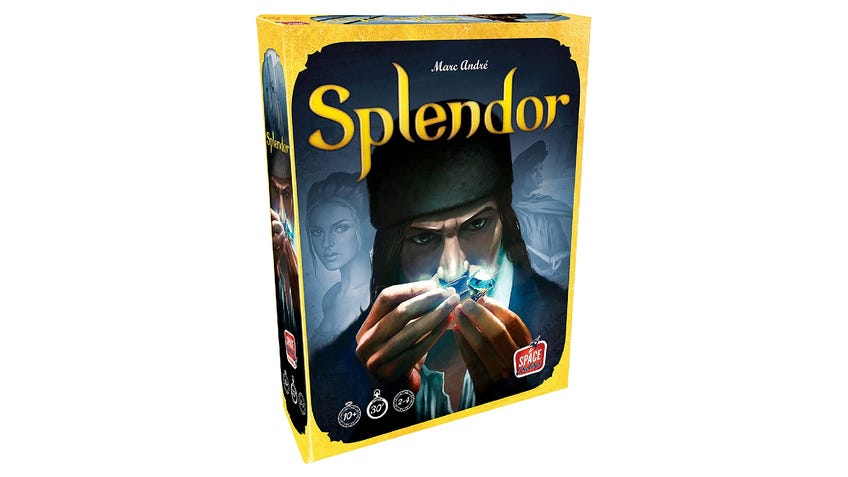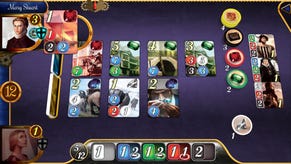How to play Splendor: board game’s rules, setup and scoring explained
Get to grips with this gem of a card game.
Splendor is the 2014 award-winning engine-building game that promises to turn you and your friends into Renaissance jewellery magnates. This modern classic boasts over one million copies sold, not counting digital adaptations, variants and re-releases. It’s also a great board game for introducing new players to the hobby, given how simple it is to learn how to play Splendor and how fast setup and rules explanation can be.
How to play Splendor
- Player count, game length and overview
- Setup
- How to play with two or three players
- Splendor rules
- How to win Splendor
In Splendor, players take on the role of jewellery merchants competing for fame and, well, splendour. Each turn a player will acquire new jewels or spend some stones to grow their gem empire. You might start by building a diamond mine in the snow-white mountain peaks, but soon enough you’ll be opening your own ruby-red shop in the capital. Skilled players might even attract the attention of wealthy patrons, which is sure to raise their renown even further.
Splendor has remained popular thanks to new releases like Splendor Marvel, which turns the game’s iconic coloured jewels into the gems of Thanos’ Infinity Gauntlet, and the shorter and tighter two-player-only Splendor Duel. We’ll be looking at how to play the original Splendor, but most of the rules apply to its Marvel-themed sequel as well.
Player count, game length and overview
Splendor is a resource-management game for two to four players that plays in about 30 minutes. Players take the role of merchants racing to produce the most renowned jewellery of the Renaissance by collecting raw gems, buying developments and attracting wealthy patrons.
How to set up Splendor
Divide the development cards into their respective decks. You can tell which deck a development card belongs to by counting the white dots printed on its back. Those white dots also indicate the deck’s level, from one to three.
Shuffle the decks separately and place them in a column, with level one at the bottom and level three at the top. Reveal four cards from each deck and place them in a line next to their respective decks. You should now have a three-by-four grid of face-up development cards, each deck sitting next to a line of face-up cards of the same level.
Pick five noble tiles at random and return the rest to the box. Place those tiles where everyone can see them.
Lastly, divide the gem and gold tokens by colour and place them so that every player can reach them easily. This is the token supply.
How to play Splendor with two or three players
Splendor’s setup for two or three players is slightly different, as the game uses fewer gems and noble tiles. The number of gold tokens and development cards does not change with player count.
For a two-player game of Splendor, use only three noble tiles and four gems of each colour.
For a three-player game of Splendor, use only four noble tiles and five gems of each colour.

Splendor rules
The goal of Splendor is to be the first player to reach 15 prestige points by accumulating development cards and noble tiles. Cards and tiles are worth the number of points indicated by the white number in the top left. Cards with no number printed in the top left are worth zero points.
Starting from the first player and continuing clockwise, players must perform one action per turn. These actions include gathering gems, reserving one development card or building one development card.
Taking an action in Splendor
Gather gems: When gathering gems, choose whether to take two gems of the same colour or three gems of different colours. You can only choose to take two gems of one colour if there are at least four gems of that colour in the supply. If you end your turn with more than 10 tokens in hand (counting both gems and gold), return a number of tokens to the supply until you’re back at ten. You cannot gather gold tokens with this action, as they are not gems.
Reserve one development card: When you reserve a development card, first make sure you have fewer than three cards in your hand. If you have three or more cards in your hand, you cannot take this action. Then, draw one gold token from the supply. If there are no gold tokens left you simply don’t draw any, but you can still perform the rest of this action. Finally, take one development card into your hand. You can take any face-up development card or draw the first card of any development deck. While you can never discard a development card, you can reduce your hand size by buying a card from your hand.
Buy one development card: When you buy a development card, first select which card you want to buy. It can be one of the face-up cards on the table or one that you previously reserved and which now sits in your hand. To buy a development card, you have to spend the gem tokens indicated in the bottom-left of the card. While gem tokens are all worth one of their colour, a gold token can replace one gem of another colour. Additionally, each development card you have already bought reduces the cost of subsequent development cards by one gem of its colour.
Buying developments can be confusing at first, but we’ll make sure you get it right with an example.
Say that you want to buy a development card with a cost of two blue gems and one black gem. You use the buy action and choose the card in question. Then, you reduce the card’s price by the number of black and blue development cards you bought in the previous rounds. This means that if you’ve already built a blue development and a green one, but zero black ones, the price of this new development card is reduced by one blue. You still have to pay two gems, one blue and one black. If you want, you can use gold tokens to pay for one or both gems.

End of the turn and upkeep in Splendor
While the cards you hold in your hand are secret, the number of gems and gold tokens in your possession must be clearly visible. Any development cards you buy must also be visible to all players.
If you bought or reserved a face-up card, you must replenish that line of cards. Every time you remove a face-up card from the table, replace it with a card of the same deck. For example, if you reserved a level two development card that was lying face up in the centre of the table, take the first card of the level two deck and place it face-up where your reserved card used to be.
At the very end of your turn, check to see if you’re attracting the attention of a noble. Nobles don’t cost anything, but their price is expressed in colours, just like that of development cards. Instead of paying this cost with gems, you must meet the noble’s request by building the right development cards. For example, a noble asking for four greens and four reds will visit you once you have built four green and four red development cards. You don’t need to pay or discard anything in order to attract a noble, you only need to meet their request.
Place a visiting noble in your play area, making sure that everyone can see them clearly. You can only receive one visit from a noble per turn; if at the end of your turn you attract more than one noble, choose which one will actually visit you. You might get the other noble next turn if no-one else gets to them first. Once a noble visits a player, they will never leave their side.

How to win Splendor
The goal of Splendor is to end the game with more prestige points than any other player.
Prestige is gained through development cards and noble tiles. A card or token is worth as many prestige points as indicated by the white number printed on the top left angle of the card or noble tile. If a card has no such number, it’s worth zero points.
The last round starts once a player reaches 15 prestige points and ends right before the first player’s turn. Everyone should have played an equal number of turns right as the game ends.
The player who has the most prestige points by the end of the game is the winner. If there is a tie, the player who bought the fewest development cards is the winner.
The final score is based only on the development cards you already bought and on any visiting nobles. Reserved development cards still in your hand do not score prestige points.



